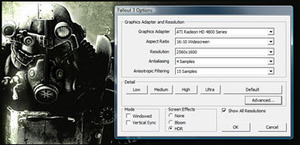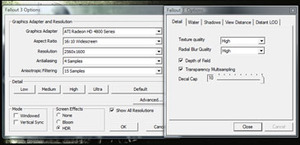Gigabyte Radeon HD 4850 1GB (GV-R485MC-1GH)
Written by Tim Smalley
November 28, 2008 | 08:24
Tags: #1gb #2 #4850 #card #durable #evaluation #hd #multi-core #performance #radeon #review #rv770 #technology #video

Fallout 3
Publisher: BethesdaFallout 3 is the revival of Interplay’s excellent Fallout series of games following many years out of the limelight. It’s developed and published by Bethesda and, judging by the success of the game, we’ll be seeing more Fallout games in the future.
Despite using the Oblivion engine which is now a few years old, the game looks absolutely stunning. Bethesda has spiced up the graphics a bit since Oblivion and has extended the engine – there are some great explosions, soft shadows and smoke effects that are particularly noteworthy.
We tested the game by manually playing a section of the game that incorporates a number of explosions and effects that you’re likely to experience during your time in post-apocalyptic Washington DC. We recorded the frame rate using FRAPS.
The in-game details were set to their highest values and both anti-aliasing and anisotropic filtering were controlled by the application settings instead of through the driver control panel. This meant that transparency anti-aliasing was enabled, along with HDR and all of the cool smoke effects.
Fallout 3’s engine is by default capped to 60 frames per second, which can make benchmark results very unclear, especially when testing at lower resolutions or with high end graphics cards. To remove the 60FPS cap you’ll need to find the Fallout3.ini file in \Documents\My Games\Fallout3 and edit the file so that iPresentInterval=0. This removes the frame rate cap, and allows us to get a much better idea of a card’s abilities.
Fallout 3
1,680 x 1,050 4xAA, 16xAF, DirectX 9, Ultra High Quality
- ATI Radeon HD 4870 X2 2GB
- ATI Radeon HD 4850 X2 2GB
- ATI Radeon HD 4870 1GB
- Nvidia GeForce GTX 280 1GB
- Nvidia Geforce GTX 260+ 896MB
- Nvidia Geforce 9800 GTX+ 512MB
- ATI Radeon HD 4870 512MB
- Gigabyte Radeon HD 4850 1GB
- ATI Radeon HD 4850 512MB
-
-
67.9
-
36.0
-
-
-
66.0
-
35.0
-
-
-
62.4
-
26.0
-
-
-
62.2
-
34.0
-
-
-
60.7
-
30.0
-
-
-
56.5
-
27.0
-
-
-
52.2
-
23.0
-
-
-
49.1
-
21.0
-
-
-
47.0
-
19.0
-
0
10
20
30
40
50
60
70
Frames per second
-
Average
-
Min
Fallout 3
1,680 x 1,050 8xAA, 16xAF, DirectX 9, Ultra High Quality
- ATI Radeon HD 4870 X2 2GB
- ATI Radeon HD 4850 X2 2GB
- ATI Radeon HD 4870 1GB
- Nvidia GeForce GTX 280 1GB
- Nvidia Geforce GTX 260+ 896MB
- Gigabyte Radeon HD 4850 1GB
- ATI Radeon HD 4870 512MB
- ATI Radeon HD 4850 512MB
- Nvidia Geforce 9800 GTX+ 512MB
-
-
66.9
-
22.0
-
-
-
64.5
-
23.0
-
-
-
59.6
-
21.0
-
-
-
57.9
-
28.0
-
-
-
52.6
-
24.0
-
-
-
45.9
-
13.0
-
-
-
41.8
-
16.0
-
-
-
37.9
-
13.0
-
-
-
37.4
- 6.0
-
0
10
20
30
40
50
60
70
Frames per second
-
Average
-
Min
Fallout 3
1,920 x 1,200 0xAA, 16xAF, DirectX 9, Ultra High Quality
- ATI Radeon HD 4870 X2 2GB
- ATI Radeon HD 4850 X2 2GB
- ATI Radeon HD 4870 1GB
- ATI Radeon HD 4870 512MB
- Nvidia GeForce GTX 280 1GB
- Nvidia Geforce GTX 260+ 896MB
- Nvidia Geforce 9800 GTX+ 512MB
- ATI Radeon HD 4850 512MB
- Gigabyte Radeon HD 4850 1GB
-
-
68.2
-
22.0
-
-
-
66.7
-
23.0
-
-
-
65.1
-
23.0
-
-
-
64.0
-
23.0
-
-
-
63.7
-
33.0
-
-
-
63.1
-
33.0
-
-
-
61.9
-
31.0
-
-
-
51.8
-
22.0
-
-
-
51.6
-
21.0
-
0
10
20
30
40
50
60
70
Frames per second
-
Average
-
Min
Fallout 3
1,920 x 1,200 4xAA, 16xAF, DirectX 9, Ultra High Quality
- ATI Radeon HD 4870 X2 2GB
- ATI Radeon HD 4850 X2 2GB
- Nvidia GeForce GTX 280 1GB
- ATI Radeon HD 4870 1GB
- Nvidia Geforce GTX 260+ 896MB
- ATI Radeon HD 4870 512MB
- Nvidia Geforce 9800 GTX+ 512MB
- Gigabyte Radeon HD 4850 1GB
- ATI Radeon HD 4850 512MB
-
-
67.9
-
23.0
-
-
-
64.8
-
22.0
-
-
-
60.6
-
31.0
-
-
-
58.1
-
23.0
-
-
-
57.1
-
30.0
-
-
-
52.9
-
21.0
-
-
-
45.2
-
17.0
-
-
-
44.7
-
17.0
-
-
-
42.9
-
16.0
-
0
10
20
30
40
50
60
70
Frames per second
-
Average
-
Min
Fallout 3
1,920 x 1,200 8xAA, 16xAF, DirectX 9, Ultra High Quality
- ATI Radeon HD 4870 X2 2GB
- ATI Radeon HD 4850 X2 2GB
- ATI Radeon HD 4870 1GB
- Nvidia GeForce GTX 280 1GB
- Nvidia Geforce GTX 260+ 896MB
- Gigabyte Radeon HD 4850 1GB
- ATI Radeon HD 4870 512MB
- ATI Radeon HD 4850 512MB
- Nvidia Geforce 9800 GTX+ 512MB
-
-
66.2
-
22.0
-
-
-
63.4
-
21.0
-
-
-
56.1
-
17.0
-
-
-
54.6
-
23.0
-
-
-
51.5
-
21.0
-
-
-
42.3
-
11.0
-
-
-
36.4
-
11.0
-
-
-
33.0
-
9.0
-
-
-
25.7
- 4.0
-
0
10
20
30
40
50
60
70
Frames per second
-
Average
-
Min
Fallout 3
2,560 x 1,600, 0xAA, 16xAF, DirectX 9, Ultra High Quality
- ATI Radeon HD 4870 X2 2GB
- ATI Radeon HD 4850 X2 2GB
- Nvidia GeForce GTX 280 1GB
- Nvidia Geforce GTX 260+ 896MB
- ATI Radeon HD 4870 1GB
- Nvidia Geforce 9800 GTX+ 512MB
- ATI Radeon HD 4870 512MB
- Gigabyte Radeon HD 4850 1GB
- ATI Radeon HD 4850 512MB
-
-
67.4
-
23.0
-
-
-
65.6
-
22.0
-
-
-
62.0
-
31.0
-
-
-
57.6
-
29.0
-
-
-
55.4
-
24.0
-
-
-
53.3
-
27.0
-
-
-
52.8
-
23.0
-
-
-
41.4
-
21.0
-
-
-
40.8
-
17.0
-
0
10
20
30
40
50
60
70
Frames per second
-
Average
-
Min
Fallout 3
2,560 x 1,600, 4xAA, 16xAF, DirectX 9, Ultra High Quality
- ATI Radeon HD 4870 X2 2GB
- Nvidia GeForce GTX 280 1GB
- Nvidia Geforce GTX 260+ 896MB
- ATI Radeon HD 4850 X2 2GB
- ATI Radeon HD 4870 1GB
- Gigabyte Radeon HD 4850 1GB
- ATI Radeon HD 4870 512MB
- Nvidia Geforce 9800 GTX+ 512MB
- ATI Radeon HD 4850 512MB
-
-
65.9
-
22.0
-
-
-
50.5
-
22.0
-
-
-
49.6
-
22.0
-
-
-
48.3
-
14.0
-
-
-
46.4
-
16.0
-
-
-
34.0
-
9.0
-
-
-
26.4
- 3.0
-
-
-
24.8
- 4.0
-
-
-
22.9
- 3.0
-
0
10
20
30
40
50
60
70
Frames per second
-
Average
-
Min
Fallout 3
2,560 x 1,600, 8xAA, 16xAF, DirectX 9, Ultra High Quality
- ATI Radeon HD 4870 X2 2GB
- ATI Radeon HD 4850 X2 2GB
- ATI Radeon HD 4870 1GB
- Nvidia GeForce GTX 280 1GB
- Nvidia Geforce GTX 260+ 896MB
- Gigabyte Radeon HD 4850 1GB
- ATI Radeon HD 4870 512MB
- ATI Radeon HD 4850 512MB
- Nvidia Geforce 9800 GTX+ 512MB
-
-
64.3
-
22.0
-
-
-
45.7
-
8.0
-
-
-
43.8
-
10.0
-
-
-
39.1
-
15.0
-
-
-
34.0
-
11.0
-
-
-
31.3
-
7.0
-
-
-
8.5
- 1.0
-
-
-
8.2
- 1.0
-
-
- 0.0
- 0.0
0
10
20
30
40
50
60
70
Frames per second
-
Average
-
Min
Not surprisingly, at lower resolutions and anti-aliasing settings, the Gigabyte Radeon HD 4850 1GB doesn't manage to pull away from its 512MB sibling. However, as soon as you enable 8xAA, there is a performance difference that becomes all the more notable as resolution increases.
At 1,680 x 1,050 8xAA 16xAF, the performance difference equates to 21 percent - this increases to 28 percent at 1,920 x 1,200 8xAA 16xAF, 48 percent at 2,560 x 1,600 4xAA and an almost fourfold increase at 2,560 x 1,600 8xAA. Even at the highest setting we tested, the Gigabyte Radeon HD 4850 1GB showed some performance advantages at a moderately playable frame rate, but the most useful gain in our eyes is at 1,920 x 1,200 8xAA because the frame rate moves from approximately 30 frames per second to over 40.











Want to comment? Please log in.